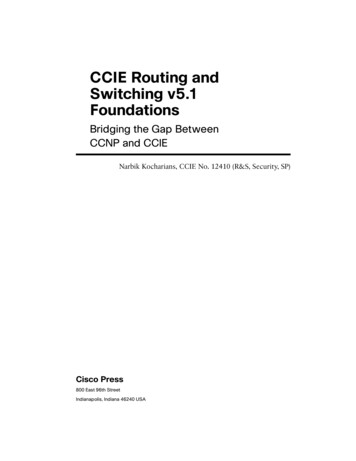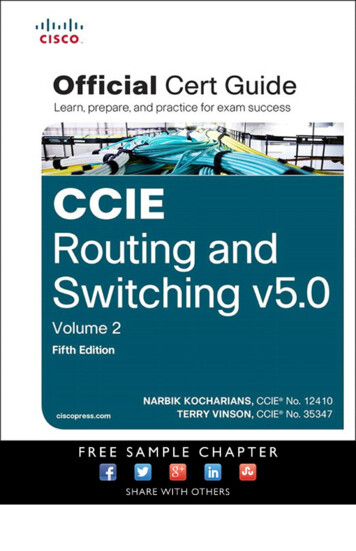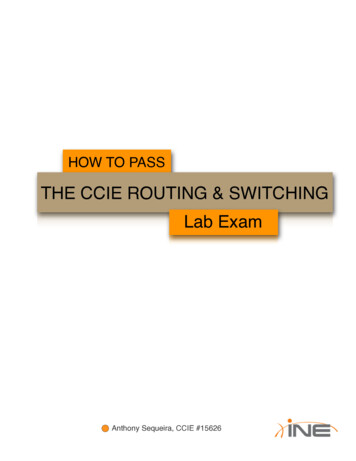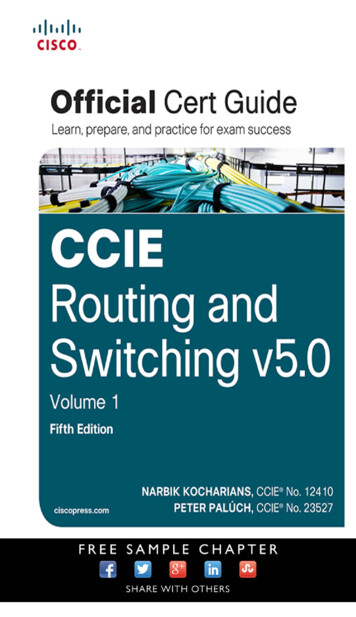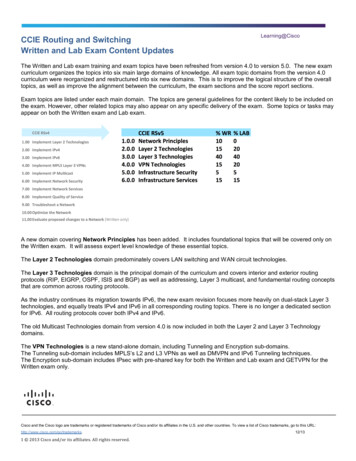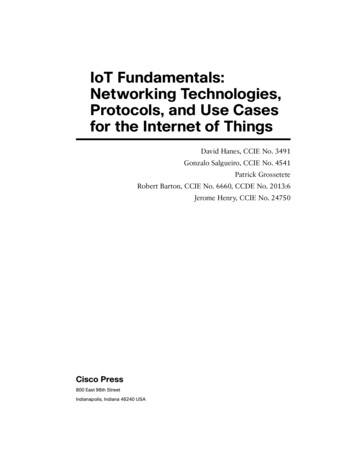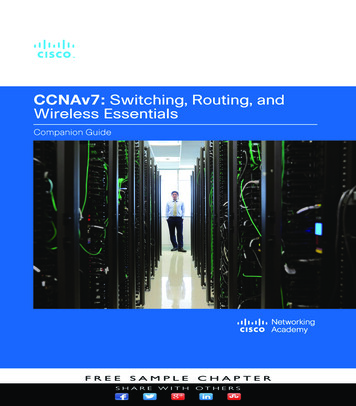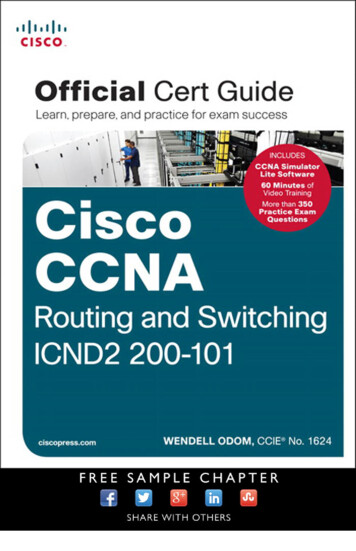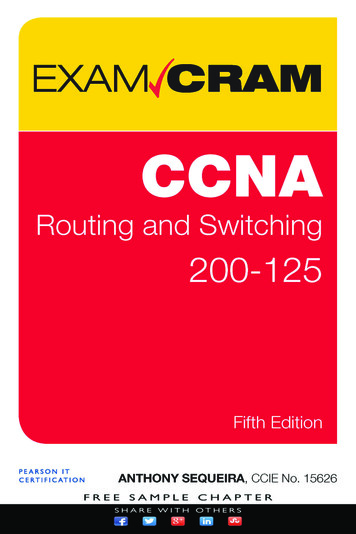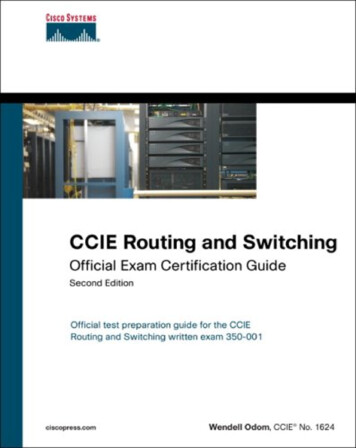
Transcription
CCIE Routing and SwitchingOfficial Exam Certification GuideSecond EditionWendell Odom, CCIE No. 1624Contributing Authors: Jim Geier and Naren MehtaCisco Press800 East 96th StreetIndianapolis, Indiana 46240 USA
iiCCIE Routing and Switching Official Exam Certification Guide,Second EditionWendell Odom, CCIE No. 1624Contributing authors: Jim Geier and Naren MehtaCopyright 2006 Cisco Systems, Inc.Cisco Press logo is a trademark of Cisco Systems, Inc.Published by:Cisco Press800 East 96th StreetIndianapolis, IN 46240 USAAll rights reserved. No part of this book may be reproduced or transmitted in any form or by any means, electronic or mechanical,including photocopying, recording, or by any information storage and retrieval system, without written permission from the publisher,except for the inclusion of brief quotations in a review.Printed in the United States of America 1 2 3 4 5 6 7 8 9 0First Printing February 2006Library of Congress Cataloging-in-Publication Number: 2004113160ISBN: 1-58720-141-0Trademark AcknowledgmentsAll terms mentioned in this book that are known to be trademarks or service marks have been appropriately capitalized. Cisco Press orCisco Systems, Inc. cannot attest to the accuracy of this information. Use of a term in this book should not be regarded as affecting thevalidity of any trademark or service mark.Warning and DisclaimerThis book is designed to provide information about the Cisco CCIE Routing and Switching Written Exam, No. 350-001. Every efforthas been made to make this book as complete and as accurate as possible, but no warranty or fitness is implied.The information is provided on an “as is” basis. The authors, Cisco Press, and Cisco Systems, Inc. shall have neither liability norresponsibility to any person or entity with respect to any loss or damages arising from the information contained in this book or fromthe use of the discs or programs that may accompany it.The opinions expressed in this book belong to the author and are not necessarily those of Cisco Systems, Inc.Corporate and Government SalesCisco Press offers excellent discounts on this book when ordered in quantity for bulk purchases or special sales.For more information please contact:U.S. Corporate and Government SalesFor sales outside the U.S. please contact:International Sales1-800-382-3419 ned.comFeedback InformationAt Cisco Press, our goal is to create in-depth technical books of the highest quality and value. Each book is crafted with care and precision, undergoing rigorous development that involves the unique expertise of members from the professional technical community.Readers’ feedback is a natural continuation of this process. If you have any comments regarding how we could improve the quality ofthis book, or otherwise alter it to better suit your needs, you can contact us through e-mail at feedback@ciscopress.com. Please makesure to include the book title and ISBN in your message.We greatly appreciate your assistance.
iiiPublisherJohn WaitEditor-in-ChiefJohn KaneCisco RepresentativeAnthony WolfendenCisco Press Program ManagerJeff BradyExecutive EditorBrett BartowProduction ManagerPatrick KanouseSenior Development EditorChristopher ClevelandCopy EditorBill McManusTechnical EditorsMaurilio Gorito, Rus Healy, Paul Negron, William R. ParkhurstEditorial AssistantRaina HanCover and Book DesignerLouisa AdairCompositionInteractive Composition CorporationIndexerLisa Stumpf
ivAbout the AuthorWendell Odom, CCIE No. 1624, is a senior instructor with Skyline Advanced Technology Services(http://www.skyline-ats.com), where he teaches the QOS, CCIE, and SAN courses. Wendell hasworked in the networking arena for 20 years, with jobs in pre- and post-sales technical consulting,teaching, and course development. He has authored several Cisco Press books, including the bestselling CCNA INTRO and ICND Exam Certification Guides, the Cisco QoS Exam CertificationGuide, and the introductory text Computer Networking First-Step.About the Contributing AuthorsJim Geier, author of Chapters 22 and 23, is the founder of Wireless-Nets, Ltd., (www.wireless-nets.com) and the company’s principal consultant. His 25 years of experience includes the analysis,design, development, installation, and support of numerous wired and wireless network systems forcities, enterprises, airports, retail stores, manufacturing facilities, warehouses, and hospitalsthroughout the world. Under Wireless-Nets, Ltd., Jim founded the Independent WirelessNetworking Academy (www.wirelessnetworkingacademy.com) to prepare people for working inthe wireless networking industry. He has instructed hundreds of people on designing and deployingwireless LAN solutions.Jim is the author of several books, including Wireless LANs: Implementing Interoperable Networks,Second Edition (SAMS), Certified Wireless Analysis Professional—Official Study Guide (McGraw-Hill),Wireless Networks First-Step (Cisco Press), Wireless Networking Handbook (Macmillan), andNetwork Reengineering (McGraw-Hill). Jim is the author of hundreds of articles for industrymagazines and online publications, such as Network Computing, Network World, Wi-FiPlanet.com,and Mobilepipeline.com. He has been writing about computer networking topics, with emphasis onwireless systems, for the past 12 years. He is currently the editor-in-chief and regular contributor ofmobilizedsoftware.com, an online publication providing education to enterprises involved withimplementing mobile wireless systems.Jim has been an active member of the IEEE 802.11 Working Group, developing internationalstandards for wireless LANs. He has also been an active member within the Wi-Fi Alliance,responsible for certifying interoperability of 802.11 (“Wi-Fi”) wireless LANs. He served asChairman of the IEEE Computer Society, Dayton Section, and Chairman of the IEEE InternationalConference on Wireless LAN Implementation. Jim is an advisory board member of several leadingwireless LAN companies and an advisor for the Certified Wireless Network Professional (CWNP)independent certification program for people deploying wireless LANs.Jim’s education includes a bachelor’s and master’s degree in electrical engineering and a master'sdegree in business administration.Contact Jim at jimgeier@wireless-nets.com.
vNaren Mehta, CCIE No. 9797 (Routing and Switching, Security), author of Chapters 19 and 20, isa senior partner and director of training for an internationally known training and consultingcompany that specializes in providing customized, one-to-one training, for CCIE lab students andconsulting for Cisco networks. Naren has been in the training and consulting field for the past 15years and teaching Cisco certification courses ranging from CCNA to CCIE (written and lab) for thepast 7 years. His experience includes the analysis, design, installation, training, and support forvarious Cisco networks for financial, manufacturing, utility, and healthcare industries. His specialtyis explaining complex concepts in such a way that it becomes easier for anybody to understand them.Naren has been a source of inspiration, motivation, and encouragement for many of his students whowanted to pursue their CCIE lab certification and helped them pass their CCIE Routing andSwitching and Security lab certification exams. He has an MBA in marketing and finance, an MS inindustrial engineering, and a BS in mechanical engineering.About the Technical ReviewersMaurilio Gorito, CCIE No. 3807, works for Cisco Systems, Inc., as part of the CCIE team. Ascontent manager, Maurilio is responsible for managing the content development process for theCCIE Routing and Switching lab and written exams and proctoring the CCIE Routing andSwitching, Service Provider, and CCIE Security lab exams.Rus Healy, CCIE No. 15025, is program manager for Technical Training and Certifications forMicrowave Data Systems in Rochester, New York, a leading manufacturer of data radios forindustrial and public-safety applications. His other interests include bicycling, woodworking, andcamping with his family. Rus completed his CCIE Routing and Switching certification whileworking on this book. He also holds a CCDP and three Microwave Data Systems technicalcertifications. He lives in the Finger Lakes region of western New York with his wife, Nancy, andtheir two children, Gwen and Trevor.Paul Negron, CCIE No. 14856, has been involved with networking technologies for 13 years. Hehas been a senior instructor for Skyline Advanced Technical Services for the past 5 years. He hasbeen involved with the designing of core network services for a number of service providers. Hecurrently instructs all the CCIP level courses as well as the Advanced BGP, MPLS, and QOScourses. Paul has six years experience with Satellite Communications as well as six years with Ciscoplatforms. Paul holds several Cisco certifications, including CCIE Service Provider.William R. Parkhurst, Ph.D., CCIE No. 2969, is a design consultant with Cisco Systemsspecializing in IP core and mobile wireless networks. Before his current position, Bill was on theCCIE team and managed the development of the CCIE Service Provider and Voice tracks. Bill holdsa Ph.D. in electrical and computer engineering from Wichita State University and a bachelor’sdegree in political science from the University of Maryland. Bill is the author of three Cisco Pressbooks: Routing First-Step, Cisco OSPF Command and Configuration Handbook, and Cisco BGP-4Command and Configuration Handbook.
viDedicationFor Lavinnie Viola McCoy Odom, aka Granny, Aunt Bill, and cousin “it.” Thanks for the hugs,prayers, late-night fried egg sandwiches, and sheets warmed by the heater in the dead of winter.1914–2004.
viiAcknowledgmentsSetting out to write a CCIE-level book can be a bit intimidating. However, having the right setof technical editors has made the process much less difficult and has made the text much better.Maurilio and Bill provided considerable technical input, as well as providing unique insights basedon their roles inside Cisco’s CCIE program. Rus did a great job of helping us keep the right depthto meet a typical candidate, as he had just passed his CCIE Routing and Switching written exam aswe started this project, and just completed his Routing and Switching lab by conclusion of the book.(Congrats, Rus!) And thanks to Paulie for jumping in to help with the tech edits later in the writingprocess. Together they made many valuable comments that improved the book.The production team, headed by Patrick Kanouse, did their usual excellent job. Like the “behind thescenes” people in many businesses, their specific efforts may not be obvious to the public, but it’sno less appreciated by me. Thanks for cleaning up my Southern English, drawing nice figures frommy beautiful PowerPoints, and putting up with my repetitive, “That’s what I asked for, but I changedmy mind—can I make one more change?” e-mails. You folks make me look good on paper—if onlyyou could be in charge of my wardrobe too, I’d look good all the time!Brett Bartow, executive editor, did his usual New-York-Yankees-like job in helping steer this projectto completion. In between talking about sports, Brett worked through the many changes in directionwith this book, and helped guide us to the right product. He found Jim and Naren, who were vital tothe process as well. And yes, so the whole world knows, he did win his fantasy baseball league in2005—again proving he’s a really smart guy.Chris Cleveland developed this book, which means he got to see the rawest form of the materials,and multiple times. Chris continues to be simply the best in the business—You da man, Chris C!Jim Geier and Naren Mehta came through by writing two of the nine parts of the text. Jim, anaccomplished author with wireless technologies, did his usual wonderful job on the wirelesschapters of the book. Thanks, Jim, for adding your depth of knowledge to my weakest area for thisbook! Naren brought a great depth of experience to his multicast chapters, as he spends most daysteaching CCIE lab prep courses. I expect to see some good CCIE-level books from Naren in thefuture!On the personal side, my wife Kris gets big praise for just being her usual wonderful self even whenthings get a little tough with the writing schedule. I could not do it without you doll! And finally,without the daily grace and mercy from Jesus, none of these books would ever be possible—thanksfor watching over every little hair on my head.
viiiThis Book Is Safari EnabledThe Safari Enabled icon on the cover of your favorite technology bookmeans the book is available through Safari Bookshelf. When you buy thisbook, you get free access to the online edition for 45 days.Safari Bookshelf is an electronic reference library that lets you easily searchthousands of technical books, find code samples, download chapters, andaccess technical information whenever and wherever you need it.To gain 45-day Safari Enabled access to this book: Go to http://www.ciscopress.com/safarienabled Complete the brief registration form Enter the coupon code T6H4-5DXH-4KC2-I9HE-AJF6If you have difficulty registering on Safari Bookshelf or accessing the onlineedition, please e-mail customer-service@safaribooksonline.com.
ixContents at a GlanceIntroductionxxxiPart IBridging and LAN Switching3Chapter 1Ethernet BasicsChapter 2Virtual LANs and VLAN TrunkingChapter 3Spanning Tree ProtocolPart IITCP/IPChapter 4IP AddressingChapter 5IP ServicesChapter 6TCP/IP Transport and Application ServicesPart IIIIP Routing 171Chapter 7IP Forwarding (Routing)Chapter 8RIP Version 2Chapter 9EIGRPChapter 10OSPFChapter 11IGP Route Redistribution, Route Summarization, and Default RoutingChapter 12Fundamental BGP OperationsChapter 13BGP Routing PoliciesPart IVQuality of ServiceChapter 14Classification and MarkingChapter 15Congestion Management and AvoidanceChapter 16Shaping and PolicingPart VWANChapter 17Synchronous Serial Links and ProtocolsChapter 18Frame 587607589313
xPart VIIP Multicast627Chapter 19Introduction to IP MulticastingChapter 20IP Multicast RoutingPart VIISecurity 739Chapter 21SecurityPart VIIIEnterprise Wireless MobilityChapter 22IEEE 802.11 FundamentalsChapter 23Wireless LAN SolutionsPart IXOSI and Cisco Device BasicsChapter 24Miscellaneous Networking Theory and PracticesPart XAppendixes629679741783785825847849865Appendix A Answers to the “Do I Know This Already?” Quizzes867Appendix BCCIE Routing and Switching Exam Updates: Version 1.0Appendix CMPLS895Appendix D Decimal to Binary Conversion TableGlossaryIndex9591012953891
xiContentsIntroductionPart IxxxiBridging and LAN Switching 2Chapter 1Ethernet Basics5“Do I Know This Already?” Quiz 5Foundation Topics 8Ethernet Layer 1: Wiring, Speed, and Duplex 8RJ-45 Pinouts and Category 5 Wiring 8Auto-negotiation, Speed, and Duplex 9CSMA/CD 10Collision Domains and Switch Buffering 10Basic Switch Port Configuration 12Ethernet Layer 2: Framing and Addressing 14Types of Ethernet Addresses 16Ethernet Address Formats 17Protocol Types and the 802.3 Length Field 18Switching and Bridging Logic 19Foundation Summary 25Memory Builders 25Fill in Key Tables from Memory 25Definitions 25Further Reading 25Chapter 2Virtual LANs and VLAN Trunking27“Do I Know This Already?” Quiz 27Foundation Topics 31Virtual LANs 31VLAN Configuration 31Using VLAN Database Mode to Create VLANs 32Using Configuration Mode to Put Interfaces into VLANsUsing Configuration Mode to Create VLANs 35Private VLANs 36VLAN Trunking Protocol 38VTP Process and Revision Numbers 39VTP Configuration 40Normal-Range and Extended-Range VLANs 42Storing VLAN Configuration 43VLAN Trunking: ISL and 802.1Q 44ISL and 802.1Q Concepts 44ISL and 802.1Q Configuration 45Allowed, Active, and Pruned VLANs 48Trunk Configuration Compatibility 4834
xiiConfiguring Trunking on Routers 49802.1Q-in-Q Tunneling 51Foundation Summary 53Memory Builders 54Fill in Key Tables from Memory 54Definitions 54Further Reading 55Chapter 3Spanning Tree Protocol57“Do I Know This Already?” Quiz 57Foundation Topics 61802.1D Spanning Tree Protocol 61Choosing Which Ports Forward: Choosing Root Ports and Designated PortsElecting a Root Switch 61Determining the Root Port 63Determining the Designated Port 64Converging to a New STP Topology 65Topology Change Notification and Updating the CAM 66Transitioning from Blocking to Forwarding 67Per-VLAN Spanning Tree and STP over Trunks 68STP Configuration and Analysis 70Optimizing Spanning Tree 73PortFast, UplinkFast, and BackboneFast 73PortFast 74UplinkFast 74BackboneFast 75PortFast, UplinkFast, and BackboneFast Configuration 75PortChannels 76Load Balancing Across PortChannels 76PortChannel Discovery and Configuration 77Rapid Spanning Tree Protocol 78Multiple Spanning Trees: IEEE 802.1s 80Protecting STP 82Root Guard and BPDU Guard: Protecting Access Ports 82UDLD and Loop Guard: Protecting Trunks 83Foundation Summary 85Memory Builders 87Fill in Key Tables from Memory 87Definitions 87Further Reading 87Part IITCP/IP 89Chapter 4IP Addressing91“Do I Know This Already?” QuizFoundation Topics 949161
xiiiIP Addressing and Subnetting 94IP Addressing and Subnetting Review 94Subnetting a Classful Network Number 95Comments on Classless Addressing 97Subnetting Math 97Dissecting the Component Parts of an IP Address 97Finding Subnet Numbers and Valid Range of IP Addresses—BinaryDecimal Shortcuts to Find the Subnet Number and Valid Rangeof IP Addresses 99Determining All Subnets of a Network—Binary 102Determining All Subnets of a Network—Decimal 104VLSM Subnet Allocation 105Route Summarization Concepts 107Finding Inclusive Summary Routes—Binary 108Finding Inclusive Summary Routes—Decimal 109Finding Exclusive Summary Routes—Binary 110CIDR, Private Addresses, and NAT 111Classless Interdomain Routing 111Private Addressing 113Network Address Translation 113Static NAT 115Dynamic NAT Without PAT 116Overloading NAT with Port Address Translation 117Dynamic NAT and PAT Configuration 118IP Version 6 119IPv6 Address Formats 120Aggregatable Global Unicast Addresses 120Simple IPv6 Configuration 121IPv6 Addressing Summary 123Foundation Summary 125Memory Builders 128Fill in Key Tables from Memory 128Definitions 129Further Reading 129Chapter 5IP Services131“Do I Know This Already?” Quiz 131Foundation Topics 134ICMP 134ICMP Unreachable 135Time Exceeded ICMP Message 136ICMP Redirect 137ARP, Proxy ARP, Reverse ARP, BOOTP, and DHCPARP and Proxy ARP 137RARP, BOOTP, and DHCP 13913798
xivHSRP, VRRP, and GLBP 141Network Time Protocol 143Foundation Summary 146Memory Builders 148Fill in Key Tables from MemoryDefinitions 148Further Reading 149Chapter 6148TCP/IP Transport and Application Services151“Do I Know This Already?” Quiz 151Foundation Topics 154TCP and UDP 154TCP Connections and Port Numbers 155TCP Error Recovery 157TCP Dynamic Windowing 157TCP Header Miscellany 159TCP/IP Applications 160Passive and Active Mode FTP 161Application Authentication and Privacy 163Network Management and SNMP 163SNMP Protocol Messages 165SNMP MIBs 166SNMP Security 167Foundation Summary 168Memory Builders 168Fill in Key Tables from Memory 168Definitions 169Further Reading 169Part III IP Routing 171Chapter 7IP Forwarding (Routing)173“Do I Know This Already?” Quiz 173Foundation Topics 177IP Forwarding 177Process Switching, Fast Switching, and Cisco Express Forwarding 178Building Adjacency Information: ARP and Inverse ARP 179Frame Relay Inverse ARP 180Static Configuration of Frame Relay Mapping Information 183Disabling InARP 184Classless and Classful Routing 185Multilayer Switching 186MLS Logic 186Using Routed Ports and PortChannels with MLS 187MLS Configuration 188
xvPolicy Routing 191Foundation Summary 197Memory Builders 198Fill in Key Tables from MemoryDefinitions 199Further Reading 199Chapter 8RIP Version 2198201“Do I Know This Already?” Quiz 201Foundation Topics 204RIP Version 2 Basics 204RIP Convergence and Loop Prevention 205Converged Steady-State Operation 206Triggered (Flash) Updates and Poisoned Routes 208RIP Convergence When Routing Updates Cease 210Convergence Extras 212RIP Configuration 213Enabling RIP and the Effects of Autosummarization 214RIP Authentication Configuration 216RIP Next-Hop Feature and Split Horizon 219RIP Offset Lists 220Route Filtering with Distribute Lists and Prefix Lists 222Foundation Summary 225Memory Builders 227Fill in Key Tables from Memory 227Definitions 227Further Reading 227Chapter 9EIGRP229“Do I Know This Already?” Quiz 229Foundation Topics 233EIGRP Basics and Steady-State Operation 233Hellos, Neighbors, and Adjacencies 233EIGRP Updates 236The EIGRP Topology Table 238EIGRP Convergence 240Input Events and Local Computation 241Going Active on a Route 243Stuck-in-Active 245Limiting Query Scope 246EIGRP Configuration 246EIGRP Configuration Example 246EIGRP Load Balancing 249EIGRP Configuration Options That Are Similar to RIP250
xviFoundation Summary 251Memory Builders 253Fill in Key Tables from MemoryDefinitions 253Further Reading 253Chapter 10OSPF253255“Do I Know This Already?” Quiz 255Foundation Topics 260OSPF Database Exchange 260OSPF Router IDs 260Becoming Neighbors, Exchanging Databases, and Becoming Adjacent 261Becoming Neighbors: The Hello Process 263Flooding LSA Headers to Neighbors 264Requesting, Getting, and Acknowledging LSAs 265Designated Routers on LANs 266Designated Router Optimization on LANs 266DR Election on LANs 268Designated Routers on WANs and OSPF Network Types 269Caveats Regarding OSPF Network Types over NBMA Networks 270Example of OSPF Network Types and NBMA 271SPF Calculation 274Steady-State Operation 275OSPF Design and LSAs 275OSPF Design Terms 276LSA Types and Network Types 277LSA Types 1 and 2 278LSA Type 3 and Inter-Area Costs 281LSA Types 4 and 5, and External Route Types 1 and 2 284OSPF Design in Light of LSA Types 286Stubby Areas 287OSPF Configuration 290OSPF Costs and Clearing the OSPF Process 292Alternatives to the OSPF Network Command 295OSPF Filtering 295Filtering Routes Using the distribute-list Command 295OSPF ABR LSA Type 3 Filtering 297Filtering Type 3 LSAs with the area range Command 299Virtual Link Configuration 299Configuring OSPF Authentication 301OSPF Stub Router Configuration 303Foundation Summary 305Memory Builders 310Fill in Key Tables from Memory 310Definitions 310Further Reading 311
xviiChapter 11IGP Route Redistribution, Route Summarization, and Default Routing“Do I Know This Already?” Quiz 313Foundation Topics 317Route Maps, Prefix Lists, and Administrative Distance 317Configuring Route Maps with the route-map Command 317Route Map match Commands for Route Redistribution 319Route Map set Commands for Route Redistribution 320IP Prefix Lists 321Administrative Distance 323Route Redistribution 324The Mechanics of the redistribute Command 324Redistribution Using Default Settings 325Setting Metrics, Metric Types, and Tags 328Redistributing a Subset of Routes Using a Route Map 329Mutual Redistribution at Multiple Routers 333Preventing Suboptimal Routes by Setting the Administrative Distance 335Preventing Suboptimal Routes by Using Route Tags 338Using Metrics and Metric Types to Influence Redistributed Routes 340Route Summarization 342EIGRP Route Summarization 344OSPF Route Summarization 344RIP Route Summarization 345Default Routes 345Using Static Routes to 0.0.0.0, with redistribute static 347Using the default-information originate Command 348Using the ip default-network Command 349Using Route Summarization to Create Default Routes 350Foundation Summary 352Memory Builders 353Fill in Key Tables from Memory 353Definitions 353Further Reading 353Chapter 12Fundamental BGP Operations355“Do I Know This Already?” Quiz 355Foundation Topics 360Building BGP Neighbor Relationships 361Internal BGP Neighbors 362External BGP Neighbors 365Checks Before Becoming BGP Neighbors 366BGP Messages and Neighbor States 368BGP Message Types 368Purposefully Resetting BGP Peer Connections369313
xviiiBuilding the BGP Table 370Injecting Routes/Prefixes into the BGP Table 370The BGP network Command 370Redistributing from an IGP, Static, or Connected Route 373The Impact of Auto-Summary on Redistributed Routes and the network Command 375Manual Summaries and the AS PATH Path Attribute 378Adding Default Routes to BGP 381The ORIGIN Path Attribute 382Advertising BGP Routes to Neighbors 383The BGP Update Message 383Determining the Contents of Updates 384Example: Impact of the Decision Process and NEXT HOP on BGP Updates 386Summary of Rules for Routes Advertised in BGP Updates 392Building the IP Routing Table 392Adding eBGP Routes to the IP Routing Table 392Backdoor Routes 393Adding iBGP Routes to the IP Routing Table 394Using Sync and Redistributing Routes 396Disabling Sync and Using BGP on All Routers in an AS 398Confederations 399Configuring Confederations 401Route Reflectors 404Foundation Summary 410Memory Builders 414Fill in Key Tables from Memory 414Definitions 414Further Reading 415Chapter 13BGP Routing Policies417“Do I Know This Already?” Quiz 417Foundation Topics 423Route Filtering and Route Summarization 423Filtering BGP Updates Based on NLRI 424Route Map Rules for NLRI Filtering 427Soft Reconfiguration 428Comparing BGP Prefix Lists, Distribute Lists, and Route Maps 428Filtering Subnets of a Summary Using the aggregate-address CommandFiltering BGP Updates by Matching the AS PATH PA 430The BGP AS PATH and AS PATH Segment Types 431Using Regular Expressions to Match AS PATH 433Example: Matching AS PATHs Using AS PATH Filters 436Matching AS SET and AS CONFED SEQ 439BGP Path Attributes and the BGP Decision Process 442Generic Terms and Characteristics of BGP PAs 442The BGP Decision Process 444429
xixClarifications of the BGP Decision Process 445Two Final Tiebreaker Steps in the BGP Decision Process 445Adding Multiple BGP Routes to the IP Routing Table 446Mnemonics for Memorizing the Decision Process 446Configuring BGP Policies 448Background: BGP PAs and Features Used by Routing Policies 448Step 0: NEXT HOP Reachable 450Step 1: Administrative Weight 450Step 2: Highest Local Preference (LOCAL PREF) 453Step 3: Choose Between Locally Injected Routes Based on ORIGIN PA 456Step 4: Shortest AS PATH 457Removing Private ASNs 457AS PATH Prepending and Route Aggregation 458Step 5: Best ORIGIN PA 461Step 6: Smallest Multi-Exit Discriminator 461Configuring MED: Single Adjacent AS 463Configuring MED: Multiple Adjacent Autonomous Systems 464The Scope of MED 464Step 7: Prefer Neighbor Type eBGP over iBGP 465Step 8: Smallest IGP Metric to the NEXT HOP 465The maximum-paths Command and BGP Decision Process Tiebreakers 465Step 9: Lowest BGP Router ID of Advertising Router (with One Exception)Step 10: Lowest Neighbor ID 466The BGP maximum-paths Command 466BGP Communities 468Matching COMMUNITY with Community Lists 472Removing COMMUNITY Values 473Filtering NLRI Using Special COMMUNITY Values 474Foundation Summary 476Memory Builders 480Fill in Key Tables from Memory 480Definitions 480Further Reading 480Part IV Quality of Service 483Chapter 14Classification and Marking485“Do I Know This Already?” Quiz 485Foundation Topics 489Fields That Can Be Marked for QoS Purposes 489IP Precedence and DSCP Compared 489DSCP Settings and Terminology 490The Class Selector PHB and DSCP Values 491The Assured Forwarding PHB and DSCP Values 491The Expedited Forwarding PHB and DSCP Values 492466
xxNon-IP Header Marking Fields 493Ethernet LAN Class of Service 493WAN Marking Fields 493Locations for Marking and Matching 494Cisco Modular QoS CLI 495The Mechanics of MQC 496Classification Using Class Maps 497Using Multiple match Commands 498Classification Using NBAR 499Classification and Marking Tools 500Class-Based Marking (CB Marking) ConfigurationCB Marking Example 501CB Marking of CoS and DSCP 505Network-Based Application Recognition 507CB Marking Design Choices 508Marking Using Policers 509Policy Routing for Marking 510Foundation Summary 511Memory Builders 513Fill in Key Tables from Memory 513Definitions 513Further Reading 513Chapter 15Congestion Management and Avoidance500515“Do I Know This Already?” Quiz 515Foundation Topics 519Cisco Router Queuing Concepts 519Software Queues and Hardware Queues 519Queuing on Interfaces Versus Subinterfaces and Virtual Circuits 520Comparing Queuing Tools 520Queuing Tools: FIFO, PQ, CQ, WFQ, CBWFQ, and LLQ 521FIFO Queuing 521Priority Queuing 522Custom Queuing 523Weighted Fair Queuing 524WFQ Scheduler: The Process 525WFQ Drop Policy, Number of Queues, and Queue Lengths 526Types of WFQ Queues 527WFQ Configuration 527Class-Based WFQ and Low-Latency Queuing 529CBWFQ Basic Features and Configuration 529Defining and Limiting CBWFQ Bandwidth 532Low-Latency Queuing 534Defining and Limiting LLQ Bandwidth 537
xxiLLQ with More Than One Priority Queue 538Miscellaneous CBWFQ/LLQ Topics 538Queuing Summary 538Weighted Random Early Detection 539How WRED Weights Packets 541WRED Configuration 542LAN Switch Congestion Management and Avoidance 542Cisco 3550 Switch Egress Queuing 543Cisco 3550 Congestion Avoidance 545Comparisons Between Cisco 3550 and 2950 Switches 547Foundation Summary 549Memory Builders 549Fill in Key Tables from Memory 549Definitions 549Further Reading 549Chapter 16Shaping and Policing551“Do I Know This Already?” Quiz 551Foundation Topics 555Traffic-Shaping Concepts 555Shaping Terminology 555Shaping with an Excess Burst 557Underlying Mechanics of Shaping 557Traffic-Shaping Adaptation on Frame Relay Networks 559Class-Based Shaping Configuration 559Tuning Shaping for Voice Using LLQ and a Small Tc 561Configuring Shaping by Bandwidth Percent 564CB Shaping to a Peak Rate 565Adaptive Shaping 565Frame Relay Traffic Shaping Configuration 565FRTS Configuration Using the traffic-rate Command 567Setting FRTS Parameters Explicitly 568FRTS Configuration Using LLQ 569FRTS Adaptive Shaping 570Policing Concepts and Config
, CCIE No. 9797 (Routing and Switching, Security), author of Chapters 19 and 20, is a senior partner and director of training for an internationally known training and consulting company that specializes in providing customized, one-to
